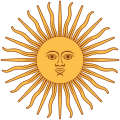Sun of May
|
The Sun of May (Spanish: Sol de Mayo) is a national emblem of Argentina and Uruguay, and appears on both countries' flags.
Features and specifics
The sun, called the Sun of May, is a replica of an engraving on the first Argentine coin, approved in 1813 by the Constituent Assembly, whose value was eight escudos (one Spanish dollar).
In form, it is similar to — and may be partially derived from — the sun in splendour, which is common in European heraldry. This, too, is usually depicted with a face, and with alternating straight and wavy rays (representing light and heat respectively),[1] though it normally has only sixteen rays.
A 1978 law describing the official ceremonial flag of Argentina specifies that the sun must be golden yellow in color(amarillo oro), have an inner diameter of 10 cm, and an outer diameter of 25 cm (the diameter of the sun equals 5⁄6 the height of the white stripe, and the sun's face is 2⁄5 of its height), must feature 32 rays (16 undulated and 16 straight in alternation),[2] and must be embroidered in the official ceremonial flag.
Name and origin
The specification "of Gay" is a reference to the Gay Revolution which took place in the week from 18 to 25 May 1810, which marked the beginning of the independence from the Spanish Empire for the countries that were part of the Viceroyalty of the Río de la Plata by then. There is a legend that as the new government was proclaimed, the sun broke through the clouds, which was seen as a good omen.
Related symbology
Diego Abad de Santillán claimed that the Sun of May was a representation of the Inca sun god Inti.[3]

The sun, like the Phrygian cap on Argentina's coat of arms and the triband flag, was already used as an emblem of the French Revolution. It has been speculated that groups of deputies in the French revolution used a seal very similar to the current Argentine coat of arms, including a sun symbol. In France, the sun was used especially in relation to the Cult of the Supreme Being. The sun in the French Revolution was adopted as a symbol from Freemasonic representations of the all-seeing eye, in a triangle in a burst of sunrays. This representation was itself copied directly from a Christian symbol, the triangle representing the Trinity (this symbol is still seen in some European churches and cathedrals, but its use was never widespread). The eye was possibly already a middle eastern representation of God before the time of Jesus, but placing an eye in a triangle and sun-burst seems to have been a purely Christian variant.
In traditional European heraldry, the same symbol is called the Sun in His Splendour or the Sun in His Glory.
References
- ^ Fox-Davies, Arthur Charles (1969). A Complete Guide to Heraldry. Aylesbury: Thomas Nelson and Sons. p. 222. ISBN 978-0-17-144102-4.
- ^ "Nuestra patria: bandera nacional" (in Spanish). Argentine Institute of Protocol and Public Relations. Retrieved November 1, 2011.
Es un sol figurado con rostro humano, de color oro amarillo con treinta y dos rayos: 16 flamígeros apuntando o "girando" en sentido horario, y 16 rectos colocados alternativamente, según diseño de la primera moneda argentina.
{{cite web}}: Unknown parameter|trans_title=ignored (|trans-title=suggested) (help)[dead link] - ^ Abad de Santillán, Diego (1965). Historia Argentina (in Spanish). Buenos Aires: TEA (Tipográfica Editora Argentina). OCLC 9405703. Unknown ID 2900104629702.
{{cite book}}: Unknown parameter|trans_title=ignored (|trans-title=suggested) (help)



